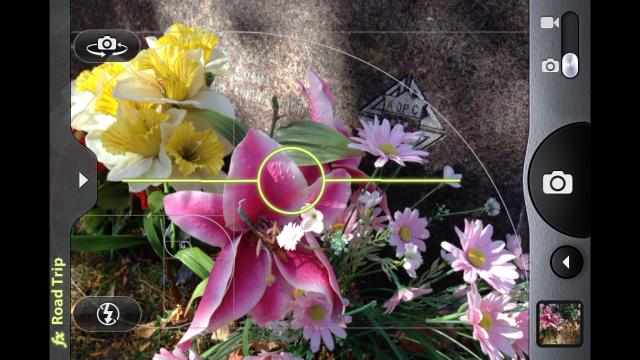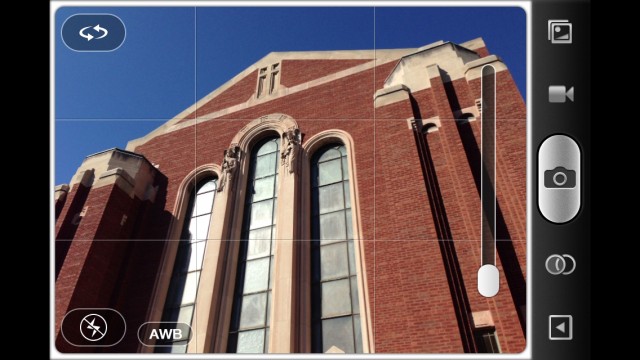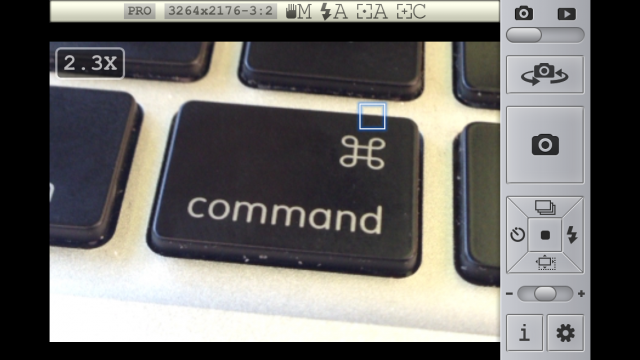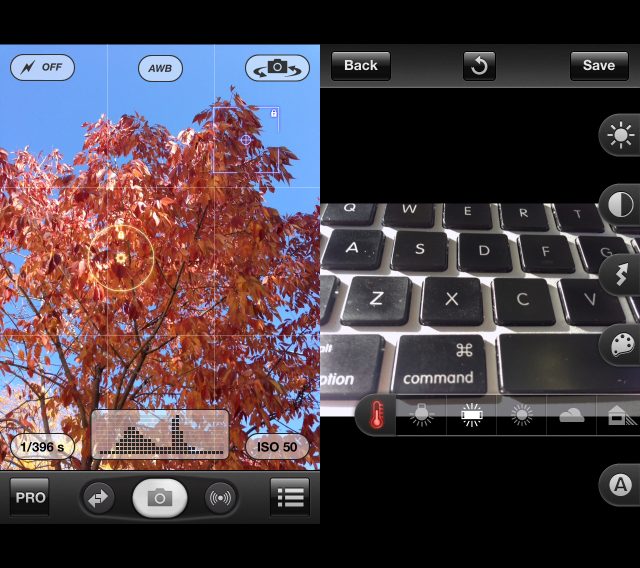
iOS's built-in Camera app is a useful piece of software, enabling the most rank amateur to take a well-exposed photo under a variety of less-than-ideal situations. At the same time, we have lamented on several occasions that Apple's built-in Camera app leaves a lot of room for improvement when it comes to advanced controls. While Apple's approach favors "tap and snap" simplicity, experienced photographers often want more control.
That added control is exactly what some third-party iOS photo apps aim to offer. We decided to take a quick look at six such apps for those looking for a Camera app alternative for your iPhone photography: 645 Pro ($2.99), Camera Awesome (free), Camera+ ($1.99), Camera Plus Pro ($1.99), Pocket Camera Pro ($0.99), and ProCamera ($2.99). Each app has a unique take on the interface, and most tend to offer similar features, as it appears that full manual control over the iPhone camera hardware isn't exposed to developers via official APIs. That said, you might find one of these apps suits your shooting style better than the Camera app.
645 Pro

645 Pro is definitely trying to woo photographers more accustomed to finely crafted mechanical cameras such as the Hasselblad 500c, Pentax 67, or Mamiya 645. Its name comes from the 6×4.5cm medium format size, which has the same proportions (4:3) as the iPhone's camera sensor. A dial allows the user to choose from common medium format sizes, including 6×6 (1:1), 6×7+ (4:5), 6×9 (3:2, same as 35mm), and 6×12 as well as 6×17 panorama formats.
The app combines skeuomorphic camera controls, an LED-style info readout, and an adjustable viewfinder. Controls are a little tricky, as each button has a "tap" and "tap and hold" control, and the virtual dials for format and virtual film type (color negative, transparency, and black and white are included) are hard to set where you want them.
A limited selection of photographic filters can also be selected by sliding from left to right on the viewfinder. Sliding up or down on the left side then chooses among the filters—cool, warm, and graduated, among others—while sliding up and down on the right side controls intensity. Filter effects and virtual "films" can be previewed before snapping by turning on the "live preview," though the viewfinder gets noticeably choppy when doing so. On the other hand, traditionalists may appreciate having to shoot first and see the results later.

Among the added picture-taking controls are independent focus, exposure and white-balance locks; a special low-light shooting mode that allows the use of longer shutter speeds; and an adjustable self-timer. You can also access live grid overlays and a real-time level. ISO and shutter speed cannot be set manually, though you can monitor the programmed values used as well as a detailed live histogram.
One last feature that really sets 645 Pro apart is the ability to save images directly to uncompressed TIFF format. These are saved as 645 Pro documents, but you can get them out of the app via several methods. 8 megapixel TIFF files are large—about 24MB—but for hardcore photographers trying to eke out every last bit of detail from an iPhone, it can make a difference, especially if you plan to use something like Photoshop for post-processing.
Camera Awesome

This app, developed by image sharing site SmugMug, is sort of a cross between Camera app and Instagram. It offers some advanced features like adjustable composition grids (including a golden ratio option), "big button" shutter release, digital anti-shake, self timer, continuous burst shooting, and intervalometer. It also comes with a selection of vintage-like filters which can be applied to each image. Camera Awesome also shoots video, whereas some Camera replacements, like 645 Pro, focus solely on stills.
As you probably surmised, Camera Awesome can be configured to automatically post every image to SmugMug. It will also post your images or videos (as applicable) to Facebook, Twitter, Flickr, Picasa, Photobucket, and YouTube.

Camera Awesome has a nice, well-designed interface, and the controls were very easy to figure out. It's perhaps not quite as powerful a photographic tool as 645 Pro, but it is an improvement over the stock app and is very simple to use.
Camera+

Camera+ was one of the earliest Camera app alternatives developed, and has a well-earned reputation for quality. Camera+ is designed to be a one-stop shooting and editing app. It doesn't have a full complement of shooting options, but it does have an image "stabilizer," self-timer, burst mode, and full-time zoom control. Images are normally saved to an internal "light box" where you can edit, share, and sync images to iCloud if you use Camera+ on multiple devices (there's also an iPad-optimized version).
Editing features include cropping, rotating, flipping, and automated "scene mode" adjustments that actually work extremely well. Choose from among "backlit" or "portrait," for instance, and tonal balance is subtly adjusted in ways that seem perfectly suited. Camera+ fans also really love the "clarity" option, which seems to magically expand the dynamic range and contrast without making the image look fake.

Unsurprisingly, Camera+ also includes a selection of "FX" filters that all look quite nice, though the "I Love Analog" filters are only available via an in-app purchase. You can also independently add one of 18 different "simple" or "styled" borders.
Once you have captured and edited an image, you can save it to your iPhone's camera roll; share it to Facebook, Twitter, or Flickr; send it in an e-mail or message; or upload it to developer TapTapTap's Camera+ sharing service, which creates a link you can post anywhere.
While the interface isn't as complex as 645 Pro, the combination of shooting, editing, and sharing makes for a very nice integrated solution.
Camera Plus Pro

Camera Plus Pro comes off as a subtle refinement to the built-in Camera app. It lacks the information displays of other apps, but adds an anti-shake feature, white-balance locking, a full-time zoom control, and a "big button" option which turns the entire viewfinder into a shutter button.

The app also includes a selection of Instagram-like live filters, several of which can also be used to shoot video. Like most photo apps, it includes several direct-sharing options, including Facebook, Twitter, Picasa, Flickr, and YouTube. It can also move images directly to a computer on your local Wi-Fi network.
Pocket Camera Pro

Pocket Camera Pro has many of the same features as the other apps we looked at, but it uses an interface reminiscent of amateur digicams. It still offers multiple image size formats, grid overlays, image stabilization, burst shooting options, a self timer, and adjustable focus and exposure locks. The controls can be difficult to set using the small five-way virtual button, however; it would be nice if users could simply tap directly on the overlay menu to get at the desired settings.

Unlike other apps, Pocket Camera Pro doesn't offer ISO or shutter information, a histogram, or white-balance lock. And the interface doesn't work well for taking vertically oriented images. While it offers more control than the native iOS Camera app, I feel it falls a little short of the "Pro" moniker.
ProCamera

ProCamera is probably on par with 645 Pro's still-shooting features, while retaining an interface that's more like the default Camera app. The large viewfinder covers most of the screen, while small overlays report shutter speed, ISO, and a live (and stylized) histogram. Overlay controls can adjust the flash and lock the white balance, while a "menu" button lets users activate anti-shake, self-timer, and "expert" modes, as well as grid and level overlays.
ProCamera also includes a nice, large focus control that can be used to lock exposure and focus independently. Simply tap and hold on the viewfinder to set your point, then drag with a second finger, and you can move the focus and exposure points to different parts of the image.
Tap the "Pro" button, and you can set additional options like anti-shake sensitivity, self-timer length, zoomed image handling, and a "big button" or "full-screen trigger" mode. Unlike 645 Pro, ProCamera will also shoot video, and it even has a special QR scanning mode (if that's something you use a lot). Like Camera+, it also includes a fairly complete set of editing features.
Recommendation
Coming from a pro photography background, 645 Pro really speaks to me with its "pro camera" interface and the ability to save full-resolution TIFFs. However, ProCamera has nearly all of the advanced power with a more iPhone-like interface, and it also includes video capture and editing features. Either of these apps would likely suit the most demanding "iPhoneographers."
If sharing with a lot of different services is of importance, Camera Awesome may be the best choice. Since it's free, there's little downside to giving it a try. Camera Plus Pro is also a good option for those looking for a bit more than what the Camera app offers, but not something radically different.
Camera+ definitely offers some amazing editing options, which all work with a simple tap. ProCamera's editing has much more control, but Camera+ worked so well it's hard to say which you might prefer. Even if you go with Camera+ for more simplicity, I don't think you'll miss out on quality adjustments, but you will have to be satisfied with less control.
The only app I hesitate to recommend is Pocket Camera Pro; while it had some interesting options, the controls were difficult to use and other apps were more complete.
Unlike the default Camera app, most of these options do cost some money. But for $3 or less, you should be able to find an option that suits your photography passion when all you have handy in your iPhone.
reader comments
56